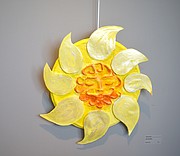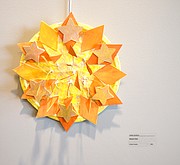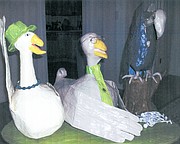‘Desert Sun’
JOEL MARTIN | Hagadone News Network | UPDATED 2 years, 6 months AGO
Joel Martin has been with the Columbia Basin Herald for more than 25 years in a variety of roles and is the most-tenured employee in the building. Martin is a married father of eight and enjoys spending time with his children and his wife, Christina. He is passionate about the paper’s mission of informing the people of the Columbia Basin because he knows it is important to record the history of the communities the publication serves. | June 7, 2023 1:30 AM
MOSES LAKE — Here in the Basin, we know we have a lot of sunshine, and we generally like it that way. But sometimes it takes a relative newcomer to give us a fresh appreciation.
“I've lived here three years now, and I love all the sunny days,” said artist Fran Church, whose exhibit “Desert Sun” is currently showing in the Ramon Cerna Community Gallery at the Moses Lake Museum & Art Center. “I thought the desert sun would be a good theme for the show since I've been doing sunbursts for a while.”
Church, 78, has taught art all over the country, she said, in Tennessee, Oregon and Arkansas. Her daughter, Dollie Boyd, is the director of the museum, and had to recuse herself from the selection process when Church applied to exhibit, she said.
The “Desert Sun” exhibit consists of six mixed-media pieces, many made from papier-mache and, of all things, used drum heads.
“My husband was a drummer,” Church explained. “He's no longer with us but he was a drummer in different kinds of bands for years, since he was 15. He would have broken drum heads, and I said ‘I think I can do something with that.’”
Many people think of papier-mache as a flimsy substance, Church said, but it doesn’t have to be.
“Papier-mache lasts a long time if you do it right,” she said. “In the 19th century, they used to make carriage sides out of papier-mache because it was lightweight. And if you Google it, you can see that people in the 19th century also occasionally made furniture out of it. I have taught kids and adults how to make papier-mache for years and years and years. And one day I just decided, ‘You know what? I can build just about anything out of papier-mache. I'm going to do some for my own work, just to see what I can do with it. And it's been a lot of fun.”
Church is a Southerner, as her soft accent makes clear as soon as she speaks. She was born on a mountaintop in Tennessee, she said, not far from the Alabama state line. She majored in art at Middle Tennessee State University in Murfreesboro, she said, and then married a man from the Northwest.
“He had a brother in Eugene, Oregon,” Church said. “That was his only family. I met and married him in Tennessee, and he said ‘Let's go to Oregon.’ Colorado was the farthest west I had been at that point. I looked on the map and said, ‘Won't we be cold?’”
Eugene turned out to have a lovely climate, Church said, and so did Port Orford, on the Oregon coast, where she taught art in the public schools.
“I had taught every grade there is, literally, from first-graders through high school seniors, “ she said. “I was a district specialist, which means they're gonna spread you as thin as they possibly can. I had to visit four different schools each day.”
She earned her master’s and then her doctorate in art education at the University of Oregon in Eugene, which at the time had the best art education program in the country, she said.
“One of my professors said, ‘Well, you're not gonna get a job because you're too old,’ she said. “I was in my 40s. Forties, I'll tell you, looks pretty darn young right now.”
The professor was dead wrong, Church said, as she already had one lined up. That job took her to Arkansas, and eventually to Alabama A&M University, a historically Black school near Huntsville.
“Huntsville is where Redstone Arsenal is, where they design space rockets,” Church said. “So there's a bunch of literal rocket scientists in Huntsville. And when I taught classes at the art museum there, I had no trouble filling a class. One day I had a roomful of people, and I said, ‘How many of you guys are rocket scientists?’ and just about everyone in the room held up their hand.”
Church’s husband passed away in 2014, and Church moved in with Boyd and her family, she said. When Boyd took over as the museum director in 2020, Church came along. She’s taught a few classes at the Moses Lake Museum & Art Center, she said, but it’s been difficult in a small town to get enough people interested.
Her artistic endeavors are becoming more difficult, Church said, because she suffers from age-related macular degeneration, which means her eyesight is going.
“It's affecting her color perception a little bit,” Boyd said. “So a lot of times, she'll get her granddaughter, my daughter, to help her like, what color is this? Is it orange, or is it more yellow?’ My daughter has a very good artistic sensibility, too. So she helps her grandma out.”
“I think her stuff has a sense of whimsy to it,” Boyd added. “And it's very bright. She loves light. She doesn't like the dark months of winter. So moving here to Moses Lake, where it's sunny most of the time, has worked out pretty well for her.”
“Desert Sun” can be seen at the Moses Lake Museum & Art Center through July 1.
Joel Martin may be reached at [email protected].
ARTICLES BY JOEL MARTIN

New home, new life
Looking back at pet adoptions in 2025
MOSES LAKE — 2025 turned out to be a good year for some pets, and some humans as well. Here are a few of the critters that found forever homes at local shelters this year.

Home team
Hayden Homes employees collect more than a ton of food for local food banks
MOSES LAKE — Hayden Homes, and its partner company Simplicity by Hayden Homes, went a step beyond their mission of affordable housing this month, with donations to organizations across the Northwest fighting food insecurity. Especially at this time of the year, it becomes more in the spotlight to think about families out there that are struggling,” said Rees Wasney, regional vice president of Hayden Homes in the Tri-Cities. “It’s a tough time.” Hayden Homes chipped in $66,000 to 15 nonprofits across Washington, Oregon, Idaho and Western Montana, according to an announcement from the company. In addition, the Hayden team amassed more than 2,500 pounds of non-perishable food for local food banks.

Nazarene Church toy swap brings needed Christmas joy
WARDEN — The Moses Lake Nazarene Church’s toy swap was scheduled for two hours Sunday afternoon, but it didn’t last nearly that long. “People were lined up from one o’clock on,” said Kaleigh Sullivan, who organized the event.







